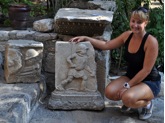(Guest post by Tessa Little)
When I first learned of the Burgaz Harbors Project I was particularly excited about the possibility to learn more about trade patterns between ancient cities. My M.A. research at Brock focuses on the transport of exotic animals for display in public spectacles: specifically how they were transported, from where they were commonly exported, and to what destinations they were sent. To help facilitate my participation in the project I wrote a funding proposal where I discussed how the presence of certain archaeological remains in harbors and on shipwrecks could explain the transport of exotic animals by sea for gladiatorial combat and other novelty activities. As I quickly have learned during the project, the evidence that I expected would be difficult, if not impossible, to find.
The primary physical evidence I hoped to find in the harbor or at any underwater site included bones, teeth, and the structural remains of cages used in transport. These objects, however, do not generally survive well underwater.
For the transport of animals such as lions, I imagined the use of iron cages. While working in the Bodrum Museum of Underwater Archaeology I soon learned that iron rusts and eventually dissolves in the sea, leaving behind what appears to be a large rock. In reality this rock reflects years of concretion that collected on the metal and was left behind when the metal dissolved. To date, no metal cages have been found at underwater sites, but I am keeping my eyes open for large cage concretions!
My next assumption was that wood– easily accessible and easy to produce–could also have been used to construct transport cages for animals less dangerous than lions. Unlike metal, wood generally survives well under water. The salinity of sea water prevents the growth of bacteria on the wood and can serve as a natural means of preservation, as does the creation of an anaerobic environment when wood is covered deeply by sand. But in a real harbor context, as I have seen this summer, the wooden remains we have found tend to be very small fragments that cannot easily provide clues to their original use or structure.
Perhaps the most obvious evidence I hoped to find to mark the transport of large, exotic animals by sea would be bones and other physical remains of animals in the harbor. Physical remains, I soon discovered, also do not survive well in an underwater environment. Organic material quickly disintegrates in the water. This is primarily because the bones and teeth I would expect to find are composed primarily of collagen and calcium, which do not survive as well in the marine environment as do ceramics and metals. Generally the deeper and more covered the organic remains, the better their condition will be. Excavation in a harbor usually entails excavation in shallow water, leaving little opportunity for the discovery of the remains of animal species I believe would be transported for public display. The physical remains we have found seem far more mundane, including the bones and teeth primarily of sheep and cows rather than wild tigers and boars.
In the end I learned that working in and under the water, specifically when looking for material that is primarily organic, can be challenging. While the remains of animals found at Burgaz can be essential to understanding economic, cultural, and trade customs of the cities in the region—particularly the dining patterns of sailors and traders–using them to understand a specific economic and cultural tradition, such as the transport of exotic animals for gladiatorial combat, remains problematic. Perhaps one day a shipwreck discovered in deep water, en route from Africa to Rome, might reveal the evidence I hoped to see at Burgaz.


